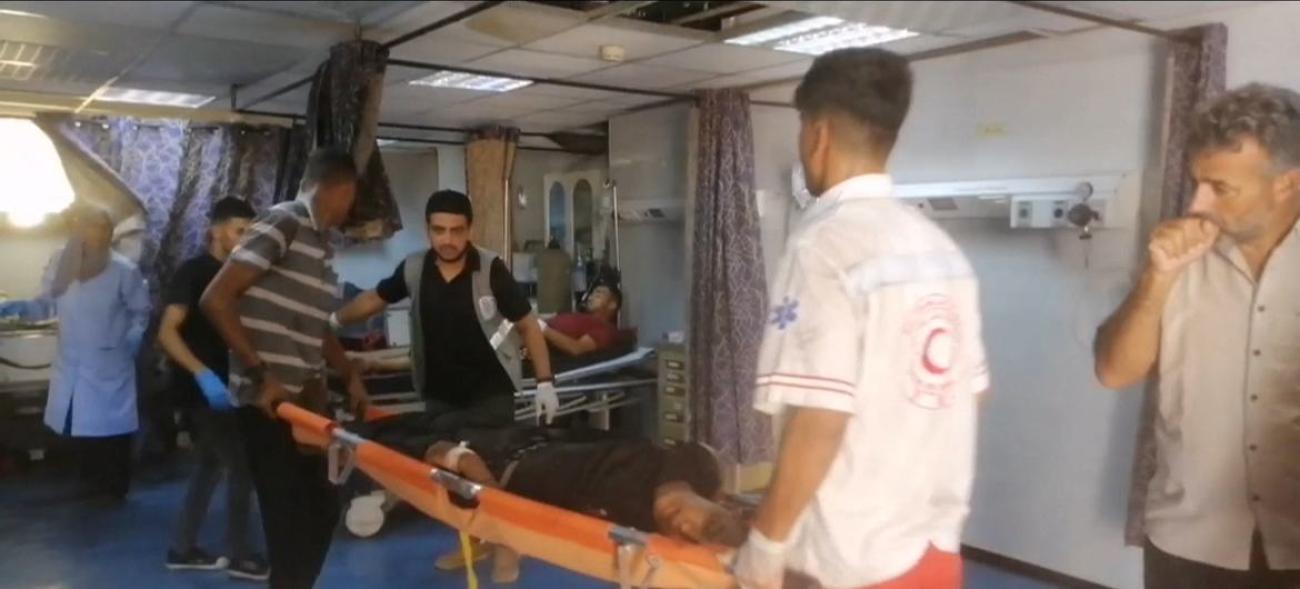UN aid official: I witnessed “some of the most horrific" scenes I had experienced in nine months in Gaza

Veteran UN aid official Scott Anderson reported witnessing “some of the most horrific" scenes he had experienced in his nine months in Gaza.
In an update from Nasser Medical Complex in Khan Younis.
“With not enough beds, hygiene equipment, sheeting or scrubs, many patients were treated on the ground without disinfectants, ventilation systems were switched off due to a lack of electricity and fuel, and the air was filled with the smell of blood,” said Mr. Anderson, Deputy Humanitarian Coordinator and Director of the UN agency for Palestine refugees (UNRWA) in Gaza.
Left on hospital floor
The overwhelmed facility received more than 100 severe cases in one day, the UNRWA official continued. “I saw toddlers who are double amputees, children paralyzed and unable to receive treatment and others separated from their parents,” Mr. Anderson said, adding that parents had moved into the “so-called humanitarian zone” of Al Mawasi, in the hope that their children would be safe there.
In a statement, the Israeli military said that it had been targeting a Hamas military commander at Al Mawasi, which lies west of Khan Younis city, by the coast. The sand and seafront zone is now home to hundreds of thousands of people, including many forcibly uprooted from Rafah in southernmost Gaza in early May ahead of an incursion by Israeli forces.
Monday’s renewed hostilities in Rafah and central Gaza followed media reports of another strike on an UNRWA school-turned-shelter on Sunday in Nuseirat refugee camp. At least 17 people are believed to have died in the attack at the school, according to the local authorities.
Two other UNRWA schools were hit last week, with 190 of the UN agency’s facilities struck since the war erupted.
Tent misery
Last Wednesday, the UN aid coordination office, OCHA, led an inter-agency mission to two informal shelter sites at Al Bureij and Al Maghazi refugee camps in Deir al Balah, central Gaza.
In Al Bureij, OCHA reported that 3,800 people were sharing 388 tents with no health services nor basic items including water and hygiene products. In Al Maghazi, more than 1,000 people including seven cancer patients were crammed into a damaged UNRWA school with no medical care, water or food.
“My colleagues from the humanitarian community are doing everything possible to increase medical capacity in Gaza, but impediments to humanitarian operations prevent us from supporting people anywhere near the scale necessary,” Mr. Anderson said, before repeating calls for an immediate ceasefire, the release of all remaining Israeli hostages taken during Hamas-led terror attacks on 7 October, and a “meaningful opportunity” for healing to begin, stressing that civilians must be protected at all times.
No escaping aid delays
Multiple obstacles continue to prevent an appropriate level of aid entering Gaza, including long delays at checkpoints and a breakdown in law and order among people desperate for food. But efforts to provide referral services, tents, beds, stretchers, disposables and medications are ongoing, Mr. Anderson said.
Around 1.9 million displaced people in Gaza face dire conditions as the conflict continues to escalate, with thousands lacking clean water, sanitation and food, according to the latest reports from humanitarian agencies.
At a school in Deir al Balah where 14,000 people are sheltering, only 25 toilets are available, UNRWA noted. An ongoing lack of fuel deliveries into the enclave has also continued to hamper aid relief operations and the running of desalination plants, hospitals and other public services, with only 25 per cent of the daily fuel needed for humanitarian operations reported to have entered Gaza so far in July, causing a 40 per cent drop in public water distribution.
And amid ever-present fears of rising levels of malnutrition among the most vulnerable, the UN World Health Organization (WHO) warned that lack of access to food, water, sanitation and basic health services was leaving people more vulnerable to disease.
Between 8 and 11 July, 152 Palestinians were killed and 392 injured, according to Gaza’s Ministry of Health (MoH). Since 7 October, at least 38,345 Palestinians have been killed and 88,295 injured, according to local health authorities in Gaza.
Gaza’s displaced ‘need everything’
Nine out of 10 Gazans are displaced and many “can’t afford to move anymore”, Deputy Humanitarian Coordinator Anderson told UN correspondents in New York on Monday, speaking from Khan Younis.
UNRWA teams are trying their hardest to make sure basic necessities such as access to food, water, medicine and hygiene kits, are being met.
Among the constant impediments to reaching people in need are restrictions on movement, safety for humanitarian staff, telecommunications challenges and fuel, he said.
“Recently there’s been a substantial breakdown in law and order”, he added, with municipal policing virtually non-existent following the Israeli order for officers to stay at home last February.
Hunger, anger, desperation
The lack of public order is having a “significant impact on our ability to bring things in, to scale”, he said, noting that truck drivers have also “been regularly threatened or assaulted.”
“We have had some challenges with people looting, which really isn’t a surprise after nine months. People are hungry, people are angry, people are desperate.”
Telling the story
Mr. Anderson also bemoaned the lack of international media access given by the Israeli military, emphasizing that factual reporting is “desperately needed” and “a very vital function by informing the public about what is happening”, especially regarding the impact on innocent civilians.
“So we would urge the Israeli authorities to allow international journalists to enter the Gaza Strip and at the same time, every effort must be made to protect the journalists and media workers wherever they are in Gaza.”
Most importantly, he told the briefing, “civilians must be protected at all times.”


